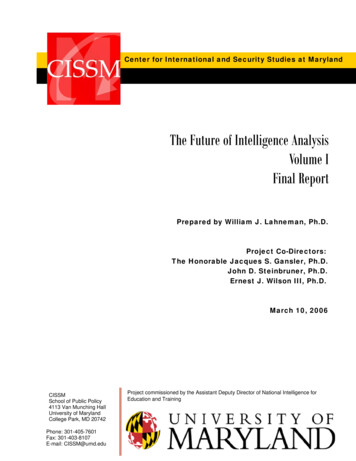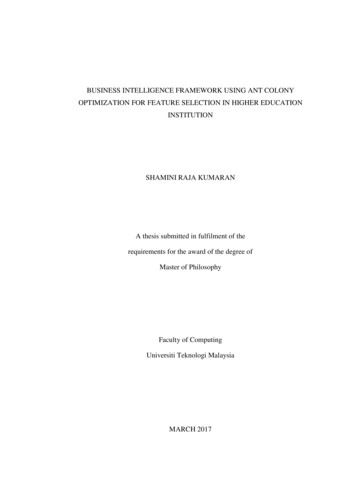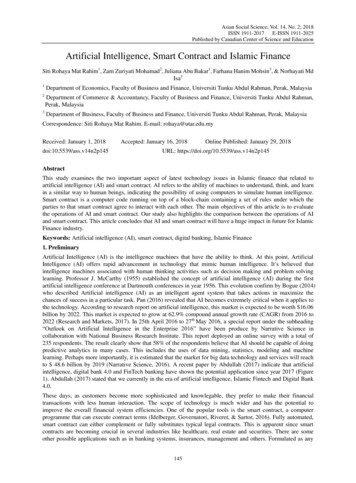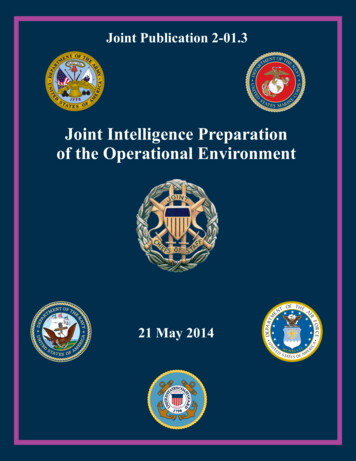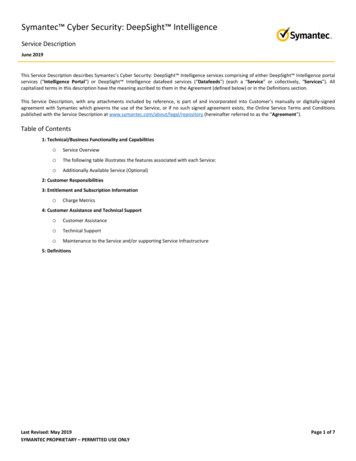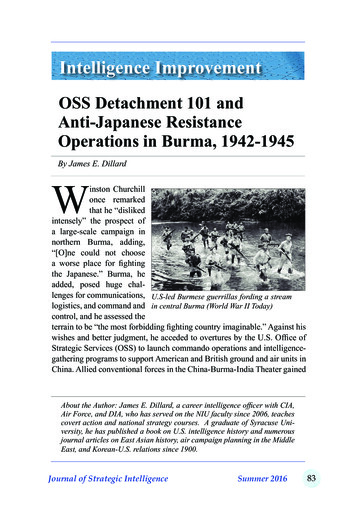
Transcription
Intelligence ImprovementOSS Detachment 101 andAnti-Japanese ResistanceOperations in Burma, 1942-1945By James E. DillardWinston Churchillonce remarkedthat he “dislikedintensely” the prospect ofa large-scale campaign innorthern Burma, adding,“[O]ne could not choosea worse place for fightingthe Japanese.” Burma, headded, posed huge challenges for communications, U.S-led Burmese guerrillas fording a streamlogistics, and command and in central Burma (World War II Today)control, and he assessed theterrain to be “the most forbidding fighting country imaginable.” Against hiswishes and better judgment, he acceded to overtures by the U.S. Office ofStrategic Services (OSS) to launch commando operations and intelligencegathering programs to support American and British ground and air units inChina. Allied conventional forces in the China-Burma-India Theater gainedAbout the Author: James E. Dillard, a career intelligence officer with CIA,Air Force, and DIA, who has served on the NIU faculty since 2006, teachescovert action and national strategy courses. A graduate of Syracuse University, he has published a book on U.S. intelligence history and numerousjournal articles on East Asian history, air campaign planning in the MiddleEast, and Korean-U.S. relations since 1900.Journal of Strategic IntelligenceSummer 201683
Intelligence Improvementa key force multiplier when OSS initiated intelligence collection and sabotage operations throughout northern Burma in the late spring of 1942.1Detachment 101 holds the distinction of being the only OSS unit whoseoperations were a critical component of and integral to the conduct of theAllied campaign in the China-Burma Theater. Detachment 101 fulfilledOSS Director William “Wild Bill” Donovan’s image of clandestine unitsaiding conventional ground and air units perhaps more than any other OSSunit, in part because of its organizational adaptability and unique combatenvironment. For the unit’s superb performance between 1942 and 1945,the OSS assessed Detachment 101 to be “its most effective combat tacticalforce.” OSS Headquarters added that the unit’s small cadre of commandoesand intelligence officers “may well come to be recognized as a model forsubversive operations under the same or analogous conditions,” and theywere pioneers “in a type of operation which may well become a classic ofmodern warfare.”2During the course of its unconventional warfare campaign, Detachment101 had, by mid-1944 channeled through three phases of a typical insurgency: infiltration and preparation, sabotage and subversion, and finallyguerrilla support to aid conventional units. However, Detachment 101’s resourceful nature and agility as a war-fighting unit allowed a unique fourthphase: the unit’s guerrillas were the only U.S.-led ground combat elementin Burma by June 1945. The structure, mission, and scope of the OSS unitin Burma made it the forerunner of today’s special forces, even though theOSS detachment is not officially recognized in the lineage of any U.S. Armyground element.3The underfunded U.S. campaign in Burma was one of the most poorlyresourced of all operational campaigns in World War II and was at the endof one of the longest logistics trails of the entire war. Due to the difficult operational environment, the few American infantry units that fought in northern Burma, such as Merrill’s Marauders, were purposely formed, organized,trained, and equipped to deal with the unique challenges of jungle warfare.Since Burma was a British colony, Churchill and his government had comMichael Warner, The Office of Strategic Services: America’s First Intelligence Agency(Washington, DC: Central Intelligence Agency, 2000), 18.2OSS Special Operations Branch History, Folder 4, Box 101, Entry 99, RG 226, NationalArchives and Records Administration (NARA), College Park, MD.3Robert Warner to William J. Donovan, “History of OSS/IBT,” April 14, 1945, NARA.184Journal of Strategic IntelligenceSummer 2016
Intelligence Improvementmand supremacy; American strategy in the Burma campaign centered onkeeping China in the war. The Japanese had occupied China’s major portssince 1938, and this left China with a tenuous and long overland route, theBurma Road, to support its forces with U.S.-supplied aid. With their invasion of 1942, the Japanese severed even this link.4With the Burma Road under enemy control, the U.S. Army Air Forceestablished airfields in Assam, India, to fly cargo aircraft via the hazardous“Hump” air bridge through the Himalayan mountain passes to China. Thisproved costly in terms of aircraft, cargos, and crews. U.S. planners devisedan alternative land route from India to bypass the original Burma Road.The new route would allow the Americans to supply the Chinese via theLedo Road. The North Burma campaign, crucial to the fighting in China,depended on securing the Ledo Road, and OSS Detachment 101 played aprominent, albeit unheralded, role in carrying out that dangerous mission.5OSS Moves Into the JungleDetachment 101 was one of two special operations units created by Donovan’s Coordinator of Information (COI) office, renamed the OSS in early1942. Under the leadership of Lieutenant Colonel Preston Goodfellow, thena U.S. Army G-2 liaison officer working for COI, a project code-namedScheme OLIVIA formed the basic outline for Detachment 101. Although theoriginal plan (dated January 27, 1942) did not call for operations in Burma,it detailed sabotage operations against Japanese establishments, facilities,and commanders in areas occupied by Japanese forces. Once LieutenantGeneral Joseph “Vinegar Joe” Stilwell, the U.S. commander in charge ofthe China-Burma-India Theater, accepted the operational plan for OLIVIA,OSS tasked Captain Carl F. Eifler, a Pearl Harbor veteran, to take chargeof Detachment 101 on April 22, 1942. Eifler selected a small group of 21officers and enlisted men with unique language and technical skills whichqualified them for overseas service in an area of responsibility (AOR) that,depending on changing circumstances, could be anywhere in China, Korea,Burma, Indo-China, or Japan. He and his men laid the groundwork for acompletely new type of paramilitary unit with no precedent in U.S. military history. With little organized training and a largely open-ended missionTroy J. Sacquety, The OSS in Burma: Jungle War against the Japanese (University Pressof Kansas, 2013), 3.5Ibid., 4.4Journal of Strategic IntelligenceSummer 201685
Intelligence Improvementto subvert Japanese operations and gain intelligence on enemy intentions,capabilities, and troop movements, Eifler somehow quickly molded his meninto a cohesive, combat-ready unit in a matter of weeks. Detachment 101headed off to war in the jungles of the Far East just as the American homefront was learning the good news of a crucial U.S. naval victory at the Battleof Midway. For the OSS commandoes of Detachment 101, victory in thestifling summer heat and incessant monsoons would seem far from certainand a long way off.6Captain Eifler was soon promoted to major, but he engaged in fruitlessand frustrating negotiations with Chinese authorities, leading Stilwell torecognize that Eifler’s cadre would not operate in China, since Chiang Kaishek would not allow an autonomous, secret paramilitary unit in his territory. Stilwell gave orders for Major Eifler to operate from India into Burma,adding that while he did not care how Detachment 101 disrupted Japaneselines of communication, he wanted to hear “booms” coming from the jungleof northern Burma, and he wanted to hear those “booms” within 90 days.7While dealing with bugs, parasites, skin problems, malaria, and the occasional Japanese patrol, Eifler also had to clarify his chain of command withGeneral Stilwell. Vinegar Joe agreed with Eifler and Donovan that Detachment 101 would remain an OSS unit serving under the tactical control ofStilwell’s headquarters. Stilwell’s staff began assigning Eifler’s men onlystrategic objectives and allowed the unit to figure out the best way to carrythem out. By 1943 Eifler commented in a dispatch to OSS Washington thatStilwell gave his unit a great deal of operational latitude in planning andexecuting missions. “We are practically a little Army on our own.”8 Detachment 101 had a free hand in establishing its reporting requirements to OSSHeadquarters and Donovan.The British perception of Eifler’s merry band was another story altogether. British commanders viewed OSS and especially Detachment 101with decidedly mixed emotions. On the one hand, they welcomed any effortby U.S. commandoes to degrade Japanese warfighting abilities in northKermit Roosevelt, The Overseas Targets: War Report of the OSS, vol. 2 (New York:Walker, 1976), xvii.7Heidi Vion, “Booms from Behind the Lines: An Oral History of the Covert Experiencesof the Office of Strategic Services Detachment 101 in the World War II China-Burma-IndiaTheater” (MA thesis, California State University-Fullerton, 2004), 284-285, 304-305.8Sacquety, 16-19.686Journal of Strategic IntelligenceSummer 2016
Intelligence Improvementern Burma. On the other hand, the British viewed the Americans and theirnotion of secret paramilitary raids with suspicion. A large U.S. presencein the former British colony, especially a clandestine special operationsgroup, could undermine Great Britain’s status as a colonial power sincemany Americans back home were ideologically opposed to imperialism inany form—Japanese or British. The British military and political leadershipcame to assume by winter 1944-45 that American and British interests inthe Burma AOR might diverge significantly once the war could be concluded. With India’s post-war status as a jewel in the crown of the BritishEmpire already in question by 1945, the large American presence in Burmaexacerbated British concerns about their future influence in the region as awhole. A second issue, of a far more military nature, was that an AmericanOSS unit operating in Burma’s jungles might not ever be under direct British control. This likewise could have far-reaching political and diplomaticconsequences and pose a threat to postwar British rule in Southeast Asia. Asit turned out, OSS deflected efforts by both U.S. and British regular Armyunits to gain operational control of Detachment 101, and the organizationalways controlled its paramilitary and intelligence operations.9For their base of operations, Eifler needed an isolated location near arailroad and a river and not too far from a U.S. Army supply depot. Following a tip from the British, and with the concurrence of Stilwell’s staff, Eifler found a secluded location on the grounds of the Assam Tea Estate nearNazira—dozens of square miles permitting Detachment 101 to train agentsindependently of others in the region and facilitating compartmentalization.It was important that groups of agents, assigned distinct objectives, not recognize and identify each other in the event of capture and torture, and thusthey could not give away too much valuable intelligence to the Japanese.Eifler established a jungle school on the tea plantation and began traininghis detachment. Between October 8 and Thanksgiving 1942, Eifler’s unitexpanded guerrilla training from 15 students learning skills in radio communications, demolition, security, and hand-to-hand combat to 5 groups ofagent trainees numbering over 50.10Detachment 101’s field operations in the spring of 1943 involved bothshort- and long-range penetration operations. Short-range operations were9OSS Special Operations Branch History, RG 226, NARA.Ibid.10Journal of Strategic IntelligenceSummer 201687
Intelligence Improvementshallow penetrations into enemy-held territory, usually conducted on foot.While these would be the missions that proved to Stilwell and Army regulars the value of an OSS paramilitary unit in northern Burma, only longrange penetrations would give Stilwell the desired “booms” he wanted tohear from the Burmese jungle. Such operations by Eifler’s commandoeswere the first OSS strategic sabotage missions in World War II. Long-rangepenetrations were conducted hundreds of miles into Japanese-occupied territory with personnel inserted by airborne or maritime means. All operational members of these long-range missions were recruited from Britishor Commonwealth personnel, indicating how dependent Detachment 101remained on British support at this early stage. Intelligence on Japanesecapabilities in 1943 was at a premium.11 Largely as a result of poor or nonexistent intelligence, almost all of Detachment 101’s early long-range penetration missions in 1943 were disasters; only one mission out of six provedmodestly successful in 1943. Mission failure usually resulted in the loss ofan entire team. An OSS history of Detachment 101 analyzed these dangerous (almost suicidal) long-range penetration missions, saying, “We knewwe were neophytes in this type of business, but we were determined to takeadvantage of our mistakes and not commit the same error twice if we couldpossibly avoid it. We eventually were able to isolate the sound practicesand use them to develop effective procedures.”12 The year 1943 provedcostly for the OSS operations in Burma, and by late winter and early springof 1944, Detachment 101 focused almost exclusively on short-range operations where native Kachins, who knew the treacherous terrain, acted asforce multipliers, and ably supported the commando missions. Detachment101 earned a measure of recognition and respect from Stilwell’s staff forfielding a strong guerrilla fighting force that became a thorn in the side ofJapanese soldiers in northern Burma.13Operations FORWARD and KNOTHEADOperation FORWARD, Detachment 101’s first field operation, reliedon an especially small contingent of seven highly skilled personnel basedout of Fort Hertz, a forward location on the northern Burmese border.From there the civilian agents and paramilitary officers made their way toIbid.Ibid.13Roosevelt, War Report, vol. 2, 11-26.111288Journal of Strategic IntelligenceSummer 2016
Intelligence ImprovementSumprabum, the furthest point in Burma then under Allied control. Thegroup would report on local conditions and study how Detachment 101could use the area to train agents prior to eventually launching short-rangemissions against the Japanese. Operation FORWARD gave Eifler the ideaof recruiting native Kachins for an unconventional warfare campaign. TheKachins would prove vital to the success of Detachment 101, which fundedand coordinated various Kachin anti-Japanese resistance groups in northernBurma. The best known resistance fighters were known as the Kachin Rangers. Within months of recruiting the first group of Kachins from Burma’snorthern hill country, Eifler’s detachment was sending them on infiltrationmissions behind enemy lines to gather and report valuable intelligence onJapanese troop dispositions. FORWARD helped Detachment 101 formulate the type of guerrilla tactics they would perfect by 1945. They learnedhow to win the hearts and minds of the native population via civil affairsmissions which assisted conventional and unconventional Allied forces instriking at key Japanese sites. Until the OSS detachment could evince genuine respect for the culture, customs, and social structure of the indigenousKachin population in northern Burma, many locals remained uncooperativeand deeply suspicious of the Westerners. Confidence-building measures, including frequent social gatherings to enhance personal ties of fellowshipand camaraderie, proved successful in generating more widespread supportfor OSS-led anti-Japanese resistance missions. Once Kachin elders sent signals to their followers to validate their trust in the OSS commandos, thestrong bonds between Kachin rebels and American OSS personnel werecemented. FORWARD also played an important role in rescuing downedU.S. Army Air Force crews and pilots, saving lives, and enhancing overallmission effectiveness throughout the AOR. Three distinct roles that OSSHeadquarters noted could be ascribed to Detachment 101’s Operation FORWARD would win additional recognition and resources for Eifler: supplying intelligence on Japanese targets, rescuing Allied aircrew and missingsoldiers, and recruiting native Kachins.14A follow-on mission, Operation KNOTHEAD, stepped up Eifler’sefforts to recruit Kachin guerrilla fighters and map intelligence for air andground forces. One of KNOTHEAD’s objectives was to lure Japanesesoldiers into the hill country of northern Burma so as to allow Chineseforces to more easily advance down the Hukawang Valley, a strategic locaIbid.14Journal of Strategic IntelligenceSummer 201689
Intelligence Improvementtion for both logistics and combat operations. KNOTHEAD used nine OSSpersonnel and a few locals paid in opium, an acceptable local currency.Their operation not only supplied intelligence but also expanded the useof Kachin guerrillas. General Stilwell became increasingly convinced bythe summer of 1943 that OSS missions in Burma were difference makers,especially in providing timely and accurate tactical intelligence. To Stilwell,Detachment 101’s contributions as an intelligence gathering arm of his extended AOR, albeit unconventional, far overshadowed its uses of sabotageand subversion techniques.15An era ended, however, in June 1943 when an OSS evaluation team recommended that Eifler relinquish his command for “medical reasons.” Somein Stilwell’s headquarters staff and at OSS Washington determined Eifler,soon to be promoted to colonel, had become emotionally and mentally unstable under the constant stress of combat and paramilitary mission planning. Eifler’s command style, almost always impetuous and occasionallyreckless, made him, in the eyes of Donovan, unsuitable to continue as theleader of Detachment 101 and its vital mission. Medical teams associatedwith OSS determined that Eifler was, indeed, close to a nervous breakdown.Concerns about alcohol abuse were also expressed in the field and at OSSWashington. Eifler left the scene in the summer of 1943, eventually tobe replaced, at Donovan’s suggestion, with Lieutenant Colonel William R.“Ray” Peers in December. OSS professionals, who had long described themercurial Eifler as reckless, audacious, and abrasive, portrayed Peers as “utterly reliable, analytical, deliberate and methodical.” The new detachmentcommander would need such qualities, as a major campaign lay ahead—one that would be hard fought, bloody, and brutal. 16The Campaign for Myitkyina, February-August 1944The Japanese maintained a substantial presence in northern Burma.The most important unit was the elite, battle-tested 18th Japanese Division, headquartered at Myitkyina. The 18th had helped sack Shanghai andNanking in the late 1930s and spearheaded the invasions of Malaya andSingapore in December 1941 and throughout the early months of 1942.Together with elements of the 15th, 53rd, and 33rd Divisions, the 18th gaveIbid.William R. Peers and Dean Brelis, Behind the Burma Road: The Story of America’s MostSuccessful Guerrilla Force (Boston: Little, Brown, 1963), 132.151690Journal of Strategic IntelligenceSummer 2016
Intelligence Improvementthe Japanese Imperial Army more than 50,000 troops in the area. Facingthem was an array of Allied units from three nations that made up Stilwell’sNorthern Combat Area Command: the Chinese Army in India, the threebattalions under Brigadier General Franklin D. Merrill’s command, and theBritish Chindits (officially the Indian 3rd Infantry Division). The American10th Air Force supported the Allied ground offensive in northern Burma.17Kachin guerrillas patrolled the Moguang-Myitkyina rail line until Armyinfantry secured it in August. Detachment 101 harassed Japanese troopsfleeing south from northern Burma. First Lieutenant James Ward describedthe surreal aspects of the failed Japanese retreat: “The enemy was moreor less like clay pigeons for our marksmen on the river bank, and I, whilesitting on a balcony chair overlooking the Irrawaddy River, with a carbineacross my knees, fresh fruit and cigarettes on a nearby table, fanned byan attractive native girl, would take pot shots at will at the Japs who weretrying to escape.”18 In all, Detachment 101 and its Kachin guerrillas werebelieved responsible for nearly 1,200 enemy casualties between April andAugust 1944.19Peers and Detachment 101 had three main priorities in the MyitkyinaCampaign: collecting intelligence on Japanese forces and troop dispositions, rescuing downed Allied pilots, and conducting guerrilla warfare. TheOSS unit’s impact far outweighed the small numbers of personnel it committed to the fight. Perhaps the most important result of Detachment 101’sefforts in the Myitkyina Campaign was that it validated the OSS mission inBurma and ensured increased support from the Army and OSS Washington.Peers wrote in his dispatches: “The presence of the Kachins with the Alliedforces tipped the delicately balanced scale in northern Burma in our favor.Otherwise, it could have developed into an impossible situation.”20The Final Push: January-July 1945Helping the Allied conventional forces win the Myitkyina campaign hadbeen Detachment 101’s focus in 1944. As the Japanese defensive perimeterCharles F. Romanus and Riley Sunderland, United States Army in World War II: ChinaBurma-India Theater: Stilwell’s Command Problems (Washington, DC: Center of Military History, 1987), 35, 30, 220, 366.18Ibid.19Ibid.20Roosevelt, War Report, vol. 2, 33-37.17Journal of Strategic IntelligenceSummer 201691
Intelligence Improvementbegan to shrink dramatically throughout the fall of 1944 and into the earlywinter of 1945, the detachment’s operational tempo increased, and Peerscommanded a unit far more capable of waging autonomous guerrilla warfare and collecting timely intelligence for combat battalions throughout theChina-Burma-India Theater. In February Detachment 101 took responsibility for OSS operations along Burma’s Arakan coast. The mission involveda combined operations campaign with organic land, air, and naval elements.Peers’ Air Drop Section stepped up support to Army Air Forces and guideddozens of planes to new drop zones. At least 168 personnel were transportedand 21 parachuted to field groups from C-47s, B-25s, B-24s, and C-45s.Meanwhile, Detachment 101’s intelligence dissemination capabilities improved beginning in February when a direct teletype line was laid to the10th USAAF A-2 intelligence officials. This enabled OSS to pass hot intelligence to aircrews within minutes and increased the likelihood that actionable intelligence could be used in targeting Japanese supply lines.21Hard fighting continued in the war in northern Burma and Detachment101 remained the only Allied formation in contact with Japanese forcessouth of Myitkyina for several months. Recognizing the war had finallyturned in their favor, U.S. and British forces advanced in the western partsof Burma against several shattered enemy units. In the north, a task forcecomposed of remnants of Merrill’s Marauders and various field artilleryand infantry regiments joined elements of the 14th Army and attacked thekey city of Mandalay, which the Japanese unwisely tried to hold. In effect,various British and U.S. combat units were, often in an uncoordinated fashion, using a pincers movement to roll up Japanese defenses from Mandalayall the way to Burma’s southern region. This left Rangoon vulnerable toAllied exploitation. With so many Allied combat units engaged in a final push to take the Burmese capital, Detachment 101 pivoted its primaryfocus from intelligence to guerrilla warfare—aided once again by the nativeKachin soldiers.22The capture of Rangoon was Britain’s main goal in Burma. To the OSS, itrepresented a valuable intelligence target, as well as a possible staging areafrom which to launch operations into Thailand. Agents began parachutinginto the areas just outside Rangoon in preparation for major combat operaIbid.Ibid.212292Journal of Strategic IntelligenceSummer 2016
Intelligence Improvementtions. By May 3, 1945, OSS personnel were inside the capital city, gatheringintelligence and identifying avenues of approach for maneuver units nowon the outskirts of the city. A huge intelligence coup falling into the laps ofOSS personnel was dozens of Japanese diplomatic codebooks—immenselyvaluable to Stilwell and his staff in culminating not only the Burma fightingbut also concluding successful operations against the last Japanese holdoutsin China.23July 1945 marked the official disbanding of Detachment 101. The last ofthe unit’s field radio stations went off the air on July 7, but a few membershelped reorganize and reinvent the unit one last time—when they joinedwith conventional forces and assisted with airdrops, aircrew liaison activities, and communications support missions. Even as the end seemed so nearin the Pacific, the Japanese could still be very determined and, in somecases, better armed than the last remaining OSS personnel in Burma. In thelate spring and early summer of 1945, the unit suffered its highest casualtyrate of the war—44 killed, 34 wounded, 9 missing, and 20 captured. But thedamage inflicted on the enemy was far greater. Detachment 101 personnel were responsible for killing 1,246 Japanese troops and liberating over13,000 miles of territory between early May and late June.24 Peers senta final message via OSS Washington to Donovan as the final process ofdisbanding his team began in early July: “Ray wanted me to tell you thatbreaking up 101 broke his heart.”25LegacyActivated in mid-1942 and in operation until July 1945, Detachment 101had one of the longest periods of service of any OSS group in Europe or thePacific. It was consistently able to change its operational focus and adopt newmissions to fulfill Donovan’s vision of a clandestine unit that could assist conventional forces. The initial contingent of 21 men who arrived in the ChinaBurma-India Theater in June 1942 bore little resemblance to the group thatgrew to almost a thousand OSS personnel and 10,000 indigenous troops bywar’s end.26William R. Peers to John G. Coughlin, 1 May 1945, F 228, B 20, E 110, RG 226, NARA.Ibid.25Ibid.26Sacquety, 218–20.2324Journal of Strategic IntelligenceSummer 201693
Intelligence ImprovementAmong the reasons for the group’s historic record of success was the lackof command oversight by Stilwell or any other major unit, which permitted flexibility and agility in operational intelligence and combat scenarios.While long-range penetration missions proved mostly untenable in 1942and 1943, shallow penetration missions such as FORWARD and KNOTHEAD allowed the detachment to fill roles others could not. Intelligencecollection became a core mission, making Detachment 101 the “eyes andears” of Stilwell’s command structure.27When he assumed command from Eifler in December 1943, Lieutenant Colonel Peers took a more pragmatic approach to paramilitary operations in northern Burma. Guerrilla warfare became Detachment 101’s mainrole in Burma after the Myitkyina Campaign. Under Peers, a second keyfactor evinced the resourcefulness and adaptability of the OSS unit in theBurmese jungle: freedom to change its command structure to meet evolvingmissions and new duties. Lack of oversight and direction from OSS Washington became a strong point of the unit. Under Peers, the detachment formeda new Operations section to coordinate guerrilla elements and established acentral intelligence staff to evaluate, analyze, and disseminate intelligence.Peers helped the unit develop a strategic focus by integrating psychologicalwarfare and new paramilitary tactics. Third, by concentrating on the mundane mission of liaising with other organizations, Detachment 101 becamefar more influential and effective. Especially useful were the ties developedwith British infantry units in Burma. Finally, and perhaps most importantly,indigenous Burmese fighters—the Kachins in particular—augmented thecombat and intelligence capabilities of Detachment 101 and gave the unit aunique guerrilla warfare capability unlike any previously seen in the Pacificwar. Detachment 101 became a model for Special Forces created in thepost-war era by the U.S. Army.28OSS historians credit Detachment 101 with 232 American airmen rescued, 5,447 known enemy killed, 10,000 known enemy wounded, 64 Japanese soldiers captured, 9 railroads destroyed, 51 bridges destroyed, and2,000 tons of enemy supplies destroyed. Both the Army and OSS assessthat at least 90 percent of the intelligence furnished to Stilwell’s staff originated with Detachment 101. Using air, land, and sea components; conductIbid.Ibid.272894Journal of Strategic IntelligenceSummer 2016
Intelligence Improvementing civil affairs missions; and waging psychological and guerrilla warfarefor three years; Detachment 101 became OSS’s best combat unit. Whilemany OSS units provided exceptional service to the nation during WorldWar II, including groups in France, the Balkans, and Italy, only Detachment101 in Burma became a critical element in its theater. Long after the warconcluded, analysts and operators at CIA and the Pentagon were studyinglessons learned by OSS in northern Burma and determining how those lessons could be applied in Cold War espionage settings and the jungles ofVietnam.29Ibid.29Journal of Strategic IntelligenceSummer 201695
of the Office of Strategic Services Detachment 101 in the World War II China-Burma-India Theater" (MA thesis, California State University-Fullerton, 2004), 284-285, 304-305. . Eifler established a jungle school on the tea plantation and began training his detachment. Between October 8 and Thanksgiving 1942, Eifler's unit .


